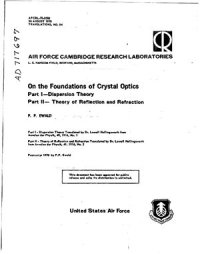
Air Force Cambridge Research Laboratories, 1970. - 110 p.
This two part paper investigates the propagation of light in the visible region through a crystalline medium.
In Part I, which is a slightly shortened version of the author's doctoral thesis of 1912, the objective is to determine if the anisotropic arrangement of ordinary (isotropic) dipoles at the nodal points of an orthorhombic lattice would account for the existence of double refraction. The value of the computed birefringence is found to be comparable to the observed value. Additionaily some features of the traditional "theory of dispersion" are disclosed and clarified. In the older theories the "Incident optical wave" plays a role but it is shown that in a medium which extends to infinity in all directions no such wave should be assumed: The refractivity is shown to arise as an internal property of the medium.
In Part II, a crystalline medium is considered as filling a half-space and having a plane boundary at z=
0. A plane optical wave is incident on this medium. Because of the linearity of the equations it has to be superimposed on the field originating in the crystal. It is shown that this incident optical wave is actually prevented from entering the crystal because of the modification produced in the field of the crystal by the introduction of a boundary. Boundary waves are found to exist on both sides of the boundary. The higher their order, the more rapidly they attenuate as a function of distance away from the boundary but the zero order waves are ordinary undampted plane raves of vacuum velocity c. The fields outside and inside the medium are connected by the Fresnel formulae: These follow from the condition that the optical field inside the medium and the oscillations generated there form a self-conisistent system.
This two part paper investigates the propagation of light in the visible region through a crystalline medium.
In Part I, which is a slightly shortened version of the author's doctoral thesis of 1912, the objective is to determine if the anisotropic arrangement of ordinary (isotropic) dipoles at the nodal points of an orthorhombic lattice would account for the existence of double refraction. The value of the computed birefringence is found to be comparable to the observed value. Additionaily some features of the traditional "theory of dispersion" are disclosed and clarified. In the older theories the "Incident optical wave" plays a role but it is shown that in a medium which extends to infinity in all directions no such wave should be assumed: The refractivity is shown to arise as an internal property of the medium.
In Part II, a crystalline medium is considered as filling a half-space and having a plane boundary at z=
0. A plane optical wave is incident on this medium. Because of the linearity of the equations it has to be superimposed on the field originating in the crystal. It is shown that this incident optical wave is actually prevented from entering the crystal because of the modification produced in the field of the crystal by the introduction of a boundary. Boundary waves are found to exist on both sides of the boundary. The higher their order, the more rapidly they attenuate as a function of distance away from the boundary but the zero order waves are ordinary undampted plane raves of vacuum velocity c. The fields outside and inside the medium are connected by the Fresnel formulae: These follow from the condition that the optical field inside the medium and the oscillations generated there form a self-conisistent system.
Download the book On the Foundations of Crystal Optics. Part I-Dispersion Theory. Part II-Theory of Reflection and Refraction for free or read online
Continue reading on any device:

Last viewed books
Related books
{related-news}
Comments (0)